Abstract
Modification of human serum albumin (HSA) with formaldehyde resulted in a loss of 75% of available lysine residues, but there was no change in histidine content or susceptibility to free-radical-mediated fragmentation. The modified HSA appeared resistant to glycation and glucose-mediated fragmentation. Native HSA inhibited oxidant production by free glucose, as assessed by the hydroxylation of benzoic acid, but modified HSA had little effect. Thus the oxidation of free glucose appeared to be inhibited by glycatable protein, but not by unglycatable protein. Also, a close proximity of glucose to protein (decreased in the case of modified HSA) would seem to be a prerequisite for glucose-mediated protein fragmentation. This latter observation, in particular, led us to examine the role of oxidation of glucose attached to HSA in the production of reactive oxidants and subsequent molecular damage. Glycated HSA, washed free of unbound glucose, became fragmented and generated oxidants capable of hydroxylating benzoic acid and oxidizing cholesteryl linoleate-HSA complexes. Significant levels of benzoate hydroxylation and HSA fragmentation occurred with HSA (10 mg/ml) containing 3.3 mol of glucose bound/mol of HSA. This is equivalent to incubation of 10 mg/ml native HSA with 0.66 mM glucose, conditions which lead to little fragmentation or oxidant formation. The oxidative activity of glycated HSA was dependent on transition-metal concentration. The level of protein-bound glucose appeared to decrease during the oxidant production and protein fragmentation. Thus glucose can oxidize and generate reactive oxidants, whether in solution or attached to protein. We discuss which is the more likely mechanism of glucose oxidation under the near-physiological conditions used to study the effects of protein exposure to glucose in vitro.
Full text
PDF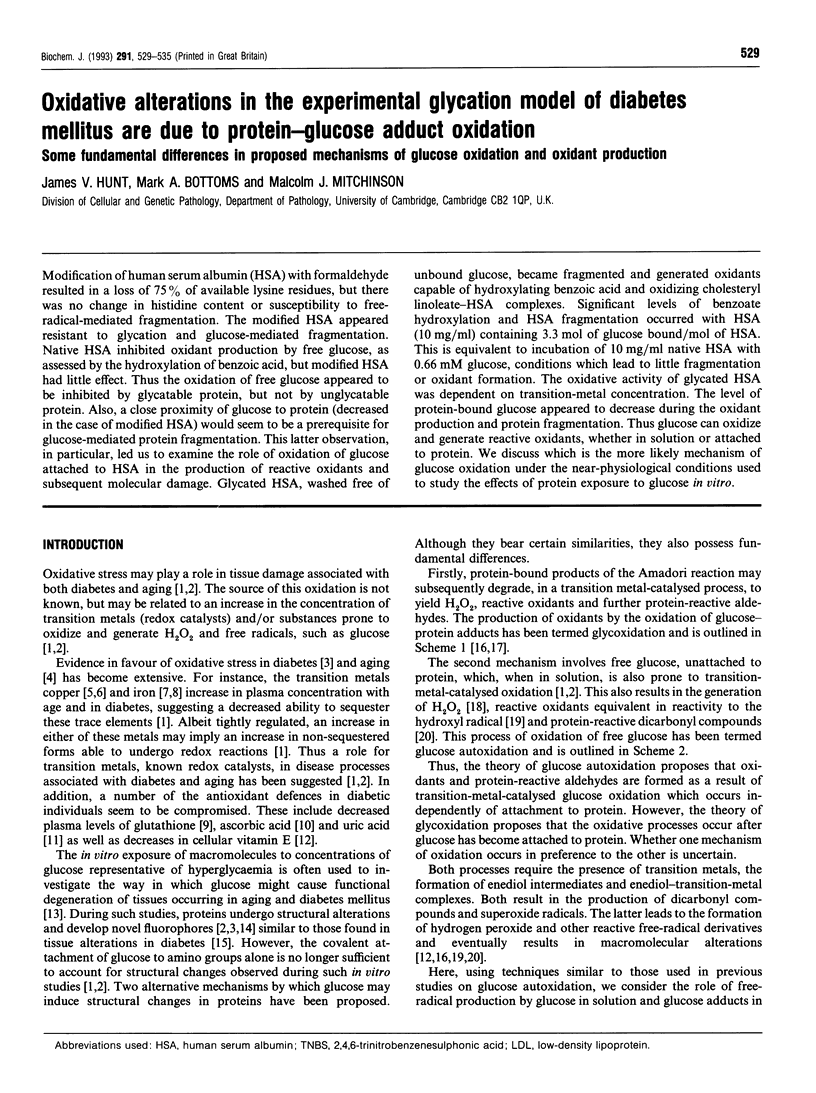
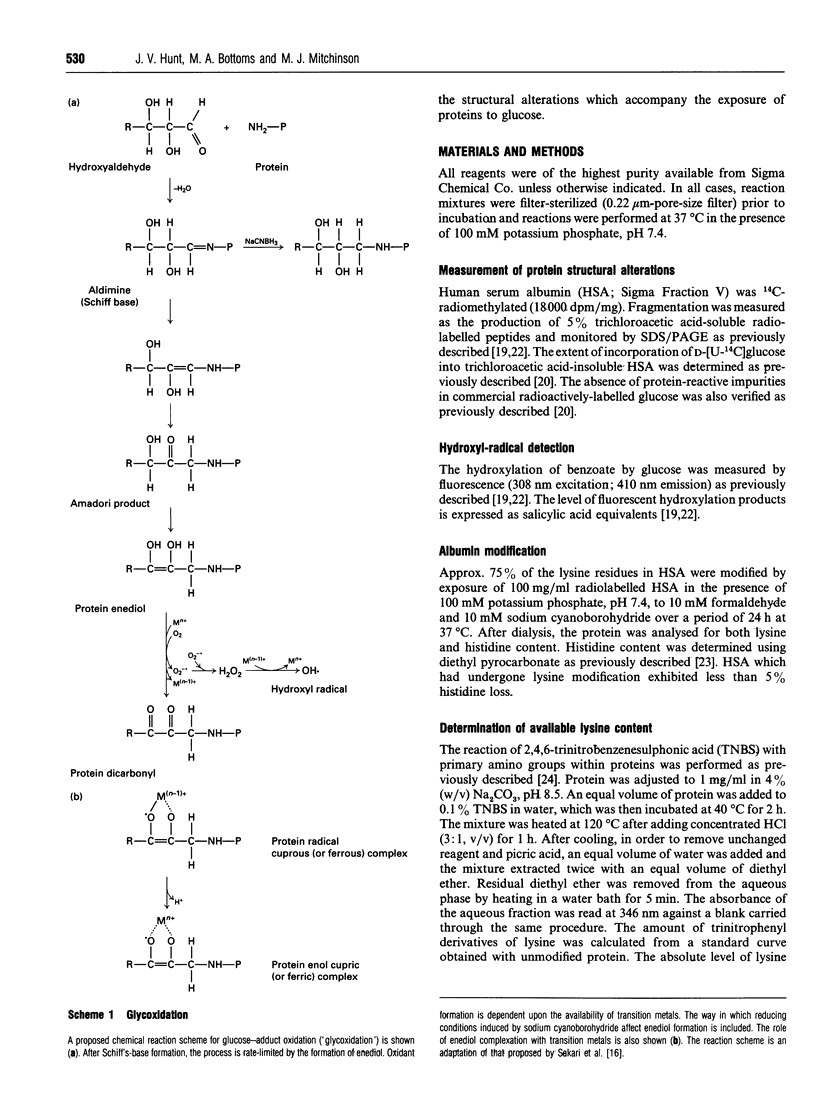
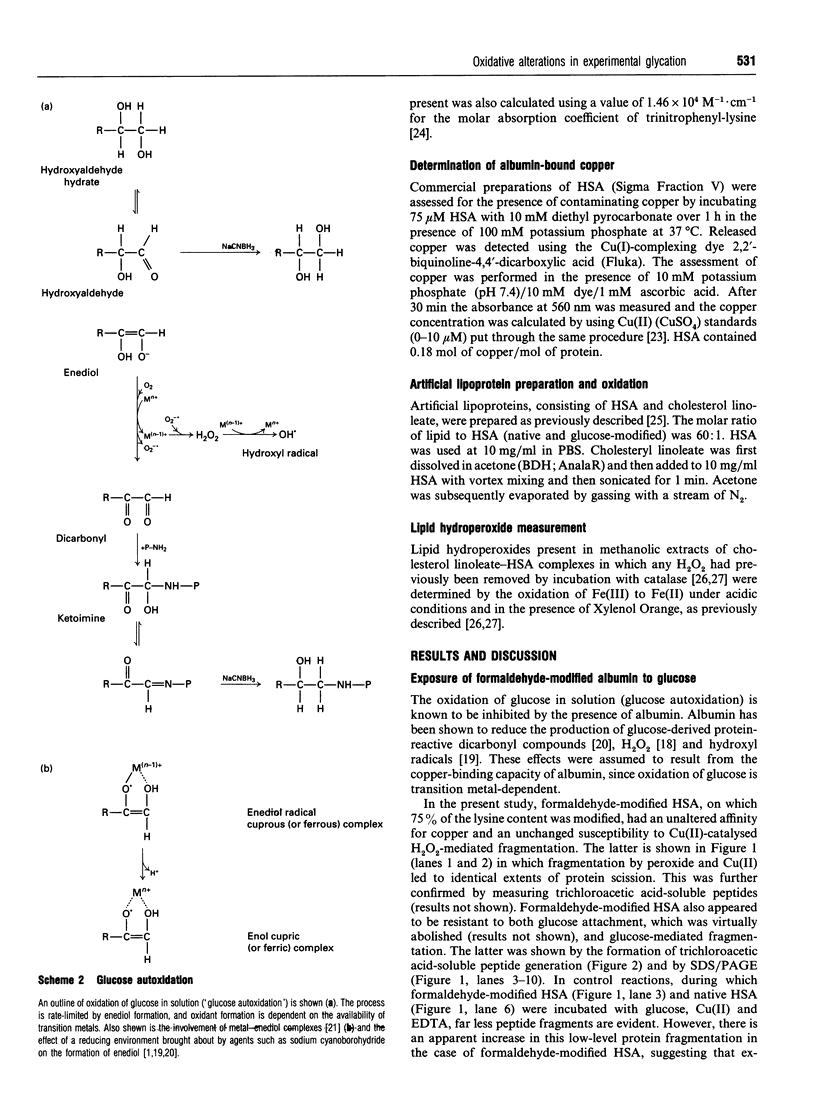

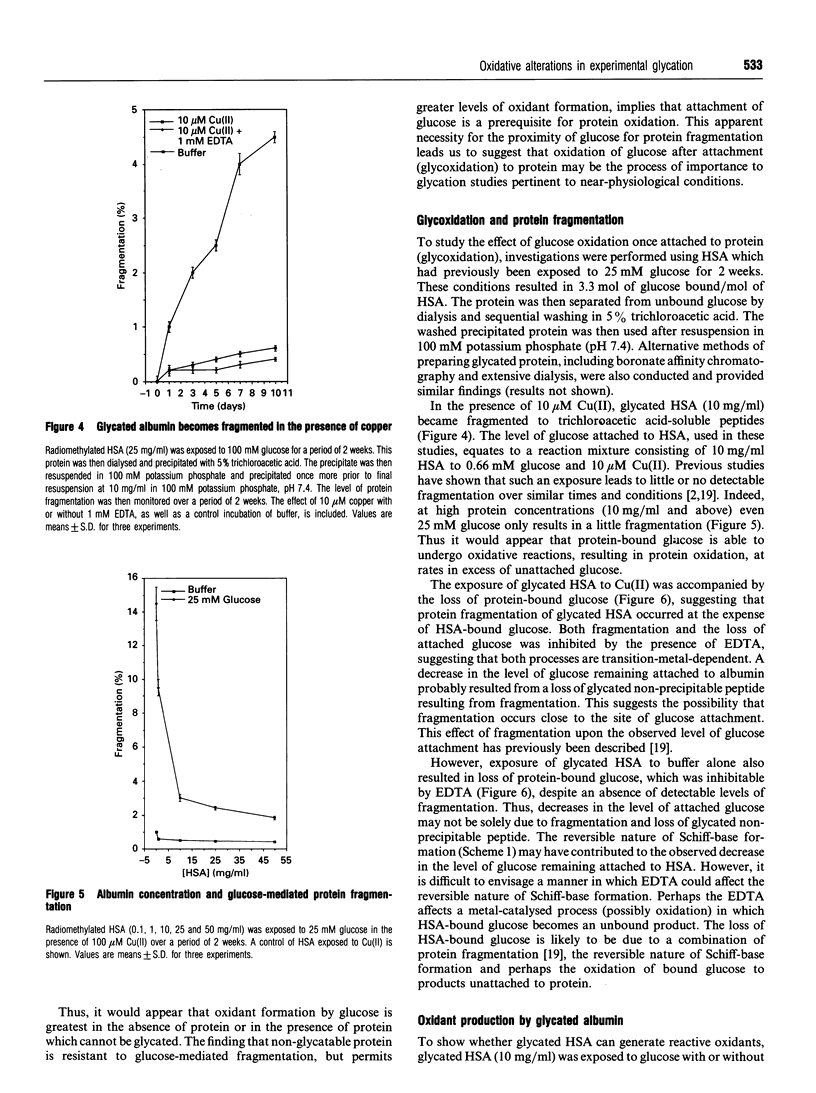
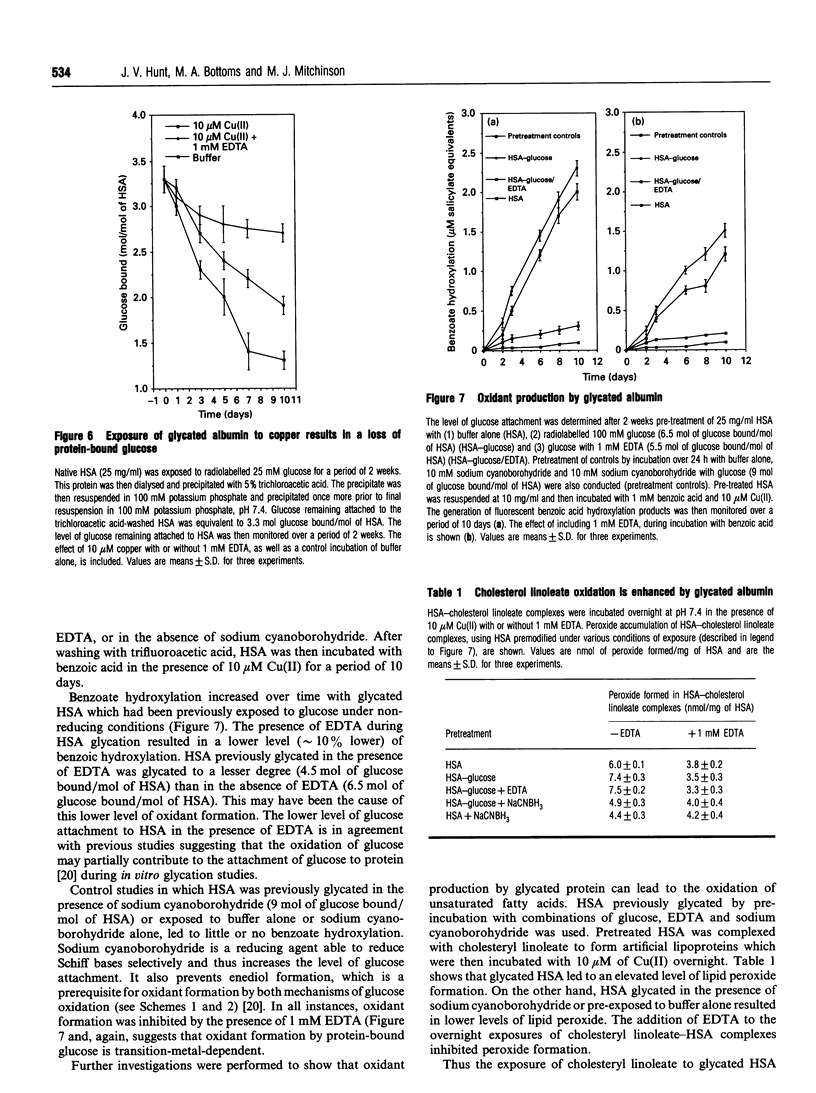
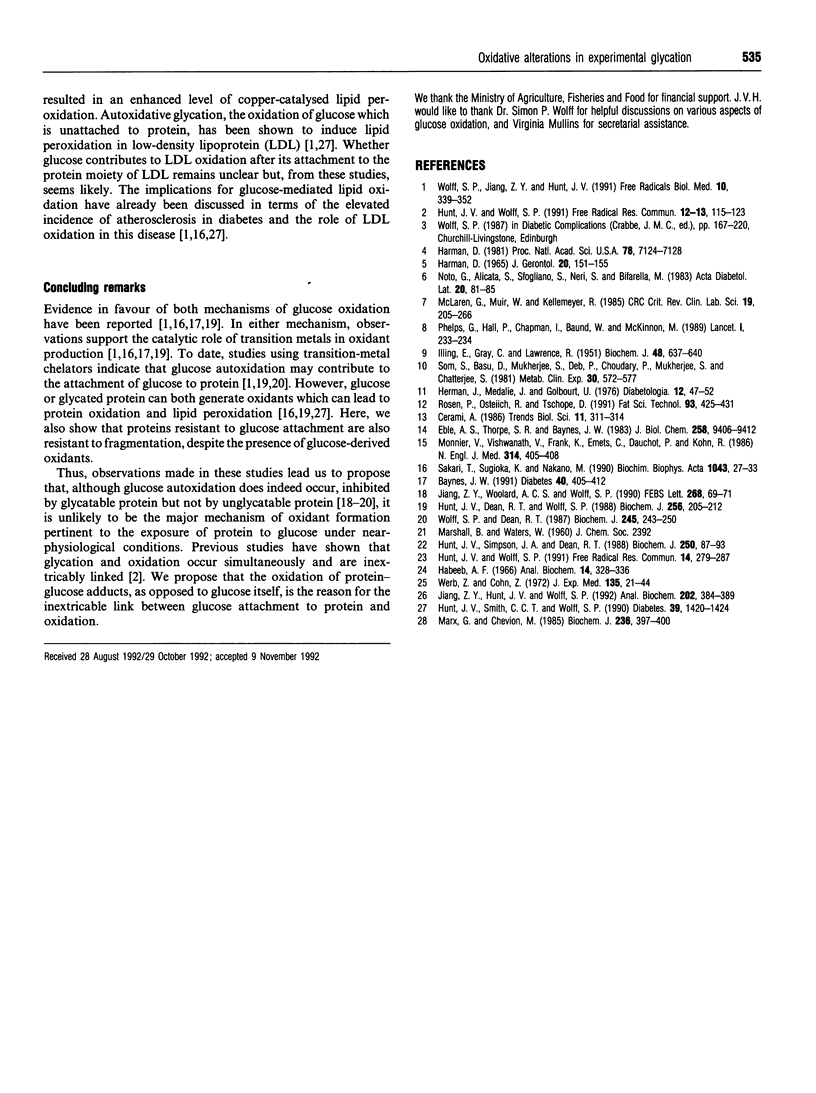
Images in this article
Selected References
These references are in PubMed. This may not be the complete list of references from this article.
- Baynes J. W. Role of oxidative stress in development of complications in diabetes. Diabetes. 1991 Apr;40(4):405–412. doi: 10.2337/diab.40.4.405. [DOI] [PubMed] [Google Scholar]
- Eble A. S., Thorpe S. R., Baynes J. W. Nonenzymatic glucosylation and glucose-dependent cross-linking of protein. J Biol Chem. 1983 Aug 10;258(15):9406–9412. [PubMed] [Google Scholar]
- HARMAN D. THE FREE RADICAL THEORY OF AGING: EFFECT OF AGE ON SERUM COPPER LEVELS. J Gerontol. 1965 Apr;20:151–153. doi: 10.1093/geronj/20.2.151. [DOI] [PubMed] [Google Scholar]
- Habeeb A. F. Determination of free amino groups in proteins by trinitrobenzenesulfonic acid. Anal Biochem. 1966 Mar;14(3):328–336. doi: 10.1016/0003-2697(66)90275-2. [DOI] [PubMed] [Google Scholar]
- Harman D. The aging process. Proc Natl Acad Sci U S A. 1981 Nov;78(11):7124–7128. doi: 10.1073/pnas.78.11.7124. [DOI] [PMC free article] [PubMed] [Google Scholar]
- Herman J. B., Medalie J. H., Goldbourt U. Diabetes, prediabetes and uricaemia. Diabetologia. 1976 Mar;12(1):47–52. doi: 10.1007/BF01221964. [DOI] [PubMed] [Google Scholar]
- Hunt J. V., Dean R. T., Wolff S. P. Hydroxyl radical production and autoxidative glycosylation. Glucose autoxidation as the cause of protein damage in the experimental glycation model of diabetes mellitus and ageing. Biochem J. 1988 Nov 15;256(1):205–212. doi: 10.1042/bj2560205. [DOI] [PMC free article] [PubMed] [Google Scholar]
- Hunt J. V., Simpson J. A., Dean R. T. Hydroperoxide-mediated fragmentation of proteins. Biochem J. 1988 Feb 15;250(1):87–93. doi: 10.1042/bj2500087. [DOI] [PMC free article] [PubMed] [Google Scholar]
- Hunt J. V., Smith C. C., Wolff S. P. Autoxidative glycosylation and possible involvement of peroxides and free radicals in LDL modification by glucose. Diabetes. 1990 Nov;39(11):1420–1424. doi: 10.2337/diab.39.11.1420. [DOI] [PubMed] [Google Scholar]
- Hunt J. V., Wolff S. P. Oxidative glycation and free radical production: a causal mechanism of diabetic complications. Free Radic Res Commun. 1991;12-13 Pt 1:115–123. doi: 10.3109/10715769109145775. [DOI] [PubMed] [Google Scholar]
- Hunt J. V., Wolff S. P. The role of histidine residues in the nonenzymic covalent attachment of glucose and ascorbic acid to protein. Free Radic Res Commun. 1991;14(4):279–287. doi: 10.3109/10715769109088957. [DOI] [PubMed] [Google Scholar]
- ILLING E. K. B., GRAY C. H., LAWRENCE R. D. Blood glutathione and non-glucose reducing substances in diabetes. Biochem J. 1951 May;48(5):637–640. doi: 10.1042/bj0480637. [DOI] [PMC free article] [PubMed] [Google Scholar]
- Jiang Z. Y., Hunt J. V., Wolff S. P. Ferrous ion oxidation in the presence of xylenol orange for detection of lipid hydroperoxide in low density lipoprotein. Anal Biochem. 1992 May 1;202(2):384–389. doi: 10.1016/0003-2697(92)90122-n. [DOI] [PubMed] [Google Scholar]
- Jiang Z. Y., Woollard A. C., Wolff S. P. Hydrogen peroxide production during experimental protein glycation. FEBS Lett. 1990 Jul 30;268(1):69–71. doi: 10.1016/0014-5793(90)80974-n. [DOI] [PubMed] [Google Scholar]
- Marx G., Chevion M. Site-specific modification of albumin by free radicals. Reaction with copper(II) and ascorbate. Biochem J. 1986 Jun 1;236(2):397–400. doi: 10.1042/bj2360397. [DOI] [PMC free article] [PubMed] [Google Scholar]
- McLaren G. D., Muir W. A., Kellermeyer R. W. Iron overload disorders: natural history, pathogenesis, diagnosis, and therapy. Crit Rev Clin Lab Sci. 1983;19(3):205–266. doi: 10.3109/10408368309165764. [DOI] [PubMed] [Google Scholar]
- Monnier V. M., Vishwanath V., Frank K. E., Elmets C. A., Dauchot P., Kohn R. R. Relation between complications of type I diabetes mellitus and collagen-linked fluorescence. N Engl J Med. 1986 Feb 13;314(7):403–408. doi: 10.1056/NEJM198602133140702. [DOI] [PubMed] [Google Scholar]
- Noto R., Alicata R., Sfogliano L., Neri S., Bifarella M. A study of cupremia in a group of elderly diabetics. Acta Diabetol Lat. 1983 Jan-Mar;20(1):81–85. doi: 10.1007/BF02629133. [DOI] [PubMed] [Google Scholar]
- Phelps G., Chapman I., Hall P., Braund W., Mackinnon M. Prevalence of genetic haemochromatosis among diabetic patients. Lancet. 1989 Jul 29;2(8657):233–234. doi: 10.1016/s0140-6736(89)90426-1. [DOI] [PubMed] [Google Scholar]
- Sakurai T., Sugioka K., Nakano M. O2- generation and lipid peroxidation during the oxidation of a glycated polypeptide, glycated polylysine, in the presence of iron-ADP. Biochim Biophys Acta. 1990 Mar 12;1043(1):27–33. doi: 10.1016/0005-2760(90)90106-8. [DOI] [PubMed] [Google Scholar]
- Som S., Basu S., Mukherjee D., Deb S., Choudhury P. R., Mukherjee S., Chatterjee S. N., Chatterjee I. B. Ascorbic acid metabolism in diabetes mellitus. Metabolism. 1981 Jun;30(6):572–577. doi: 10.1016/0026-0495(81)90133-5. [DOI] [PubMed] [Google Scholar]
- Werb Z., Cohn Z. A. Cholesterol metabolism in the macrophage. 3. Ingestion and intracellular fate of cholesterol and cholesterol esters. J Exp Med. 1972 Jan;135(1):21–44. doi: 10.1084/jem.135.1.21. [DOI] [PMC free article] [PubMed] [Google Scholar]
- Wolff S. P., Dean R. T. Glucose autoxidation and protein modification. The potential role of 'autoxidative glycosylation' in diabetes. Biochem J. 1987 Jul 1;245(1):243–250. doi: 10.1042/bj2450243. [DOI] [PMC free article] [PubMed] [Google Scholar]
- Wolff S. P., Jiang Z. Y., Hunt J. V. Protein glycation and oxidative stress in diabetes mellitus and ageing. Free Radic Biol Med. 1991;10(5):339–352. doi: 10.1016/0891-5849(91)90040-a. [DOI] [PubMed] [Google Scholar]



